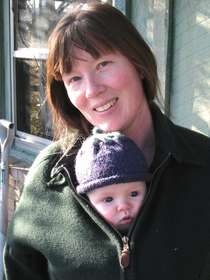 Shannon Hayes says you can find real wealth in the simple life. She blogs and farms with her husband and two daughters in West Fulton, NY, where they raise all-natural grassfed animals.
Shannon Hayes says you can find real wealth in the simple life. She blogs and farms with her husband and two daughters in West Fulton, NY, where they raise all-natural grassfed animals.
Shannon traveled across the country to find people whose lifestyle was similar to her own and included them in her new book “Radical Homemakers.” They have all chosen to have their lives revolve completely around their home and community. According to Shannon, they and their children have found a frugal yet enriched back-to-the-earth existence.
The radical homemaker’s genuine wealth, she says, comes from the soil, water, sunlight, air, family and relationships.
When I read about Shannon’s book recently, I was intrigued. Could a movement be gaining popularity that encouraged simple concepts such as hanging out the laundry to dry, cooking for your family, and getting to know your neighbors? I wondered what made this woman with a Master’s Degree and a Ph.D. switch over to a way of life that didn’t include climbing the ladder to success. How did she make this “radical homemaking” a reality?
“…while my grad school peers were settling into their new offices, I was out under a cloudless blue sky, painting for $10/hr. I decided that I had the better deal.”
Shannon took the time to explain to me why she feels home is where social change will begin…
THE WOMEN’S EYE: You’ve described radical homemaking as a “hidden revolution.” How widespread and important do you think it is?
SHANNON: I don’t know. It is hidden, because there is no way to count them. There are no professional associations, they might be listed statistically as “unemployed,” they’re invisible. But, if you look at the growth of the local food movement, as these folks are hard-core locavores, I get the sense it is pretty large, and growing fast.
EYE: What was the turning point when you decided this philosophy would be the way of life for you and your family?
SHANNON: I finished my Ph.D. and realized that every prospective job opportunity was going to pull me away from my husband, parents and family farm. We had a moment of reckoning while the ink was still fresh on my diploma, then my husband and I re-grouped and started in with the lifestyle. We worked a lot of odd jobs to hold things together then. I remember one bright, clear August day, standing on a ladder painting the top of someone’s pergola, marveling that I was a newly minted “Dr. Hayes,” and while my grad school peers were settling into their new offices, I was out under a cloudless blue sky, painting for $10/hr. I decided that I had the better deal.
EYE: You have a Master’s Degree and Ph.D. in Sustainable Agriculture and Community Development. What about criticism from some that you’re wasting your education?
SHANNON: I am very involved in the sustainable farming movement, particularly in the grassfed farming field. The advancements in sustainable farming these days are very farmer-directed. I feel very accepted there.
One of my blogs is grassfedcooking.com. I think that if I were just an academic, the farmers wouldn’t be as interested in the work I do. The fact that I live my research gives me credibility…..with farmers and folks who are on this path. As for academia, I don’t know what they’re saying about me. Perhaps they don’t even know that I exist!
EYE: This philosophy flies in the face of feminists and many working women. Can you understand their point of view?
SHANNON: I do believe there has been some criticism from feminist scholars, but I can’t keep up with what all’s being said. I know it has been suggested that my ideas and practices are “dangerous” for women, among other things. But I don’t have the time or the emotional energy to worry about it any longer. There is a lot of information and commentary out there, and if I don’t filter some of it out, it gets hard for me to deal with my day to day priorities.
“Sometimes I wish I had health insurance, but trading in a joyful existence for an insurance card seems like a lousy exchange.”
EYE: What is different about this type of homemaking compared to the homemaking of earlier times when wives in many cases felt “stuck” in a life of drudgery in the house?
SHANNON: The book goes into this in extensive detail. But to put it in as few words as possible, homemaking was once an extremely viable and socially important vocation that, prior to the industrial revolution, was done by both men and women. After the industrial revolution, men’s domestic work was replaced by factories, and they left the home to go to work there in order to garner the wages that, had the factories not existed, enabled them to purchase the goods and services that they were no longer home to provide. That is when the separate spheres (man in the factory, woman in the home) developed.
Soon, the factories figured out how to supplant the women’s duties as well, so the craft tradition of homemaking fell away, and the woman’s primary job became driving a car and shopping. Pretty mind numbing. Simultaneously, America suburbanized, and so women were now isolated in their homes, which led to a lot of depression.
Today’s RHers are different in that they are reclaiming these forgotten craft traditions — cooking, food preservation, sewing, gardening, keeping livestock, educating their children, etc. so that they do not need to be consumers any longer. They have a big picture view of the whole thing. When working with limited finances (as most of them are), if they must buy for all their needs, then they must engage in some form of social exploitation by purchasing whatever is cheapest, which is typically “cheap” because it is produced in a way that is damaging to the environment and the people who worked in the factories to produce it. By doing it themselves, they are opting for a more ecological, less exploitive life path. There is a far greater sense of purpose than driving to soccer practice and the department store.
EYE: Do you ever feel “stuck,” wishing you were working at a job away from the house?
SHANNON: No. Sometimes I wish I had health insurance, but trading in a joyful existence for an insurance card seems like a lousy exchange.
EYE: Did you have some of these homemaking skills to begin with or did you have to learn a lot of them?
SHANNON: A lot of folks around me engaged in them as I was growing up. Like most other folks, I did have to crack out the books to get a more official education on the matter, but there has always been another human being to turn to if I run into a question. Our Cooperative Extension even still has someone on staff who is a food preservation expert. That’s not always the case these days.
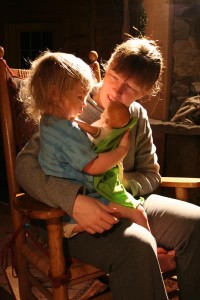
EYE: What is the toughest part of this lifestyle and the most rewarding?
SHANNON: August is pretty tough. I need to put up corn, peppers, tomatoes, beats, beans, pickles, jam, stew and peaches, plus continue with my farm duties, plus make time for kid play dates. I work a lot of extended hours, and have to keep assuring everyone around me “if we just get through August, it’s all easy rolling!” In fact, to celebrate, I schedule for us to take a week up in the Adirondacks right after Labor Day. Everyone else is back at school, and we have a lake all to ourselves. We spend every day hiking, paddling, playing games and celebrating the hard work that we’ve accomplished. So I guess that’s pretty rewarding.
In truth, I don’t think I could chose what is the “most” rewarding, because even when I’m in the throes of August, I am doing something I care about deeply, and I get to see the direct results. In the winter, there is a lot of time for hiking, playing music and rest, and by the time spring rolls around, I’m eager to be out doing stuff again.
“…the movement is asking people to question some of the biggest choices they’ve made in their lives.”
EYE: You were concerned about making this “radical” approach to homemaking public. Were there any serious repercussions?
SHANNON: There’ve been a few snarky articles, some harsh criticisms, etc. The idea seems to make some people angry. I think that is because the movement is asking people to question some of the biggest choices they’ve made in their lives (whether they were conscious of them or not): How important is a career? How is my life impacting my fellow earth citizens? How does it impact our soil, water, sunlight and air? Who should be raising my children? Growing my food? Producing for my daily domestic needs? How are my fears impacting my choices? Am I happy?
After asking themselves these questions, some people feel greatly rewarded by the answers. Others feel pretty defensive. And that leads to some bristling commentaries.
In fairness, those are pretty manageable repercussions. Obviously, my “coming out” hasn’t cost me my job! 😉
EYE: Tell me about the husbands of radical homemakers. Do they have to have certain characteristics to make this lifestyle work?
SHANNON: Very often the husbands ARE the radical homemakers.
Either way, everyone’s got to take on their share. Period. Even if someone gets a paycheck they still need to take on 50% of the duties. A home is run 168 hours per week. A typical job is 37.5 (assuming you don’t let blackberries, emails, cell phones, etc dominate the rest of your life).
“…the vast majority of folks in it now aren’t doing it out of financial desperation — they are doing it because they don’t want to be involved in soul-sucking employment…”
EYE: How do you feel about women who don’t embrace this lifestyle? Do you think more people should practice “radical homemaking?”
SHANNON: RHing is a choice. No one should be coerced into doing this. However, RHers abide by four tenets: ecological sustainability, social justice, family and community. They direct their life energy toward these aims, and resist participation in anything that works against them.
I want to see people who choose to work have the same criteria for their jobs. If something about the work is ecologically damaging, results in the exploitation of others, or infringes on a person’s ability to take care of family and community, then it is unacceptable employment. We cannot continue to run our national and international economies without expecting to honor these tenets.
” The only ‘change for the better’ would be a shift to a life serving economy…”
EYE: Is this lifestyle driven by the current economy? If it changes for the better will this movement last?
SHANNON: I think the current economy is driving more people to consider this, but the vast majority of folks in it now aren’t doing it out of financial desperation — they are doing it because they don’t want to be involved in soul-sucking employment, and because they feel personal accountability for the state of our planet. A rebound of the existing extractive economy would not be considered a change for the better to these folks. The only “change for the better” would be a shift to a life serving economy, where we work to generate a living for all, rather than a killing for a few (as David Korten puts it). And if that happens, then there will be lots more RHers.
EYE: You’ve traveled around the country talking to different homemakers for your book, sometimes in urban areas. Are there common denominators to their personalities?
SHANNON: Auto-didactic, skilled at cultivating relationships, dedicated to the principles of a life-serving economy, fearless.
EYE: You say this can apply to single parents, stay-at-home dads, widows, divorcees…how can you accomplish this as a single person?
SHANNON: See the story of Sylvia Tanner in the book. One must be skilled at cultivating relationships.
“The work of keeping a house became mindless and depressing…”
EYE: You believe “something happened when the household was no longer a unit of production but became a unit of consumption.” Explain please.
SHANNON: The work of keeping a house became mindless and depressing, and our relentless consumption has had a devastating ecological impact without making us one whit happier.
EYE: Most families you interviewed in your book “were living with a sense of abundance at about 200 percent of the federal poverty level, a little over $40,000 for a family of four”. How realistic is it to live on this kind of income?
SHANNON: I’ve been on it for 10 years. Seems pretty doable. Lots of folks in the book have been doing it for longer. They were in far better financial shape than the vast majority of Americans. Remember: they need to buy less because they are able to produce many of their needs with their own hands.
EYE: How has this lifestyle enriched the lives of your children?
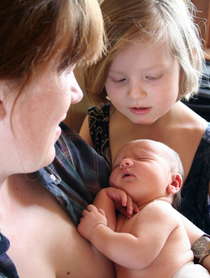 SHANNON: That’s hard to answer, since this is the only lifestyle they’ve ever known. I wouldn’t be able to track a difference the same way as someone who was once raising kids in a rat race who then made the switch. But they’re great readers, free spirits, fun to be around and have a keen sense of their natural world. Last night I was reading Winnie the Pooh to my 3-year old.
SHANNON: That’s hard to answer, since this is the only lifestyle they’ve ever known. I wouldn’t be able to track a difference the same way as someone who was once raising kids in a rat race who then made the switch. But they’re great readers, free spirits, fun to be around and have a keen sense of their natural world. Last night I was reading Winnie the Pooh to my 3-year old.
Pooh was trying to communicate with bees, and the story said he was looking among all the bees flying around, trying to find the Queen Bee. My 3-year-old stopped me promptly and said “Pooh’s wrong. The queen bee isn’t flying around. She’s supposed to stay in the hive.” (Unless, of course, she is on her nuptial flight). That’s pretty clever for a three-year-old. I don’t think she knows who Elmo is. But she seems to be up on her apiculture.
EYE: Do you expect this “radical” approach will be permanent for yourself and for your family?
SHANNON: Yes.
EYE: What is your happiest moment of the day?
SHANNON: I don’t think I could choose just one. This way of life is pretty fun.
EYE: Thanks, Shannon, for introducing us to your lifestyle.
QUESTION: Would you want to be a radical homemaker? Would it be an enriching existence for you?
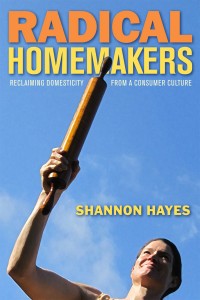
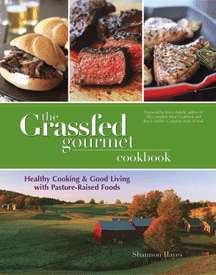
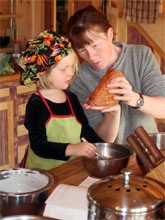

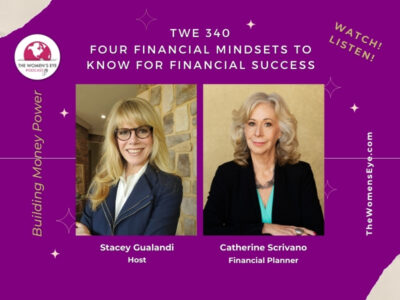
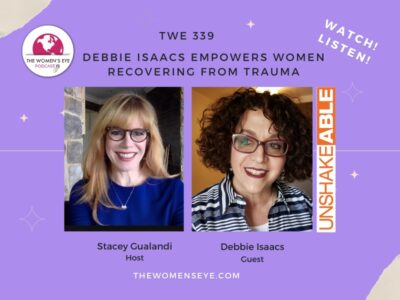
Leave a Reply